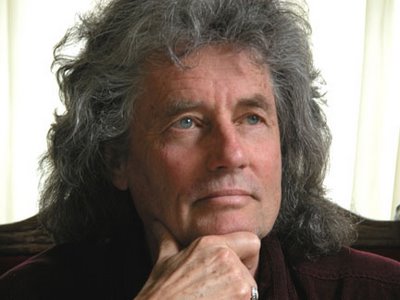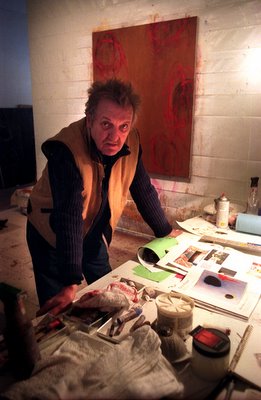
Filmmaker Robert L. Nichol. Photo courtesy stardreams-cropcircles.com
They are best seen from the air — which is probably one of the most disconcerting features about the worldwide phenomenon known as “crop circles.” But, since a wave of them began growing in the late 1970s, there have been conflicting and rather intense opinions about who or what may be creating them.
A new 77 minute documentary produced, written and directed by Robert L. Nichol titled, “Star Dreams: Exploring the Mystery of The Crop Circles,” attempts to address the questions surrounding this enigma.
In a Friday (March 24, 2006) telephone interview, Nichol said he believes “We are being communicated to by a higher intelligence and we’re basically ignoring it.”
Crop circles are a phenomenon in which elaborate geometrical designs have mysteriously appeared in fields of various crops (they have also apparently shown up in rice paddies, trees, snow fields and even iced-over ponds, according to the documentary). From the air, many of these designs appear mathematically precise, often cover a large area, and may contain references to religious, historical and cultural symbolism. Inside the pattern, plants typically have been bent reportedly at precise angles so the growth is minimally harmed, and often arranged in swirled patterns that appear shaped for effect.
The majority of crop circles tend to show up in fields near paleolithic-ceremonial sites in England (80 percent of which show up near Stonehenge, according to Nichol), but they also have been reported all over the world. It is not known if any have ever appeared in New Mexico, or Taos County, despite our own tentative connection via “cattle mutilations,” “the Taos Hum,” and many reported and unreported UFO sightings. Go figure.
The 2002 M. Night Shyamalan science fiction film, “Signs” used them as markers for hostile extraterrestrials. “They were for navigation,” Joaquin Phoenix’s character says in the film. “They made a map.”
And, obviously, a great deal of lore has developed around them, attributed to spirits, interdimensional beings, Gaia’s magnetic fields, alien orbs — and, of course, hoaxers.
The documentary’s “exploration” addresses several topics such as “What is going on?,” why there appears to be so much resistance to the idea that we are not alone in the universe, their meaning, the effect they have on humans, the appearance of unexplained lights nearby, and a possible Mars connection.
However, Nichol has taken an approach that is markedly one-sided — despite the token mention of the effect hoaxers Doug Bower and Dave Chorley have had on the true believer’s credibility in “the mainstream media.” Bower and Chorley came forward in 1991 announcing that they were responsible for making all the crop circles in southern England. A published photograph of the pair shown in the documentary is captioned with a quote, “We done ’em all.”
Chad Deetken of Pacific Research, a Canadian crop circle investigation group, was quick to jump on the immediate public reaction, stating in the documentary, “I find it quite incredible that the media picked up on Doug and Dave’s story, and without any evidence of any kind from Doug and Dave, trumpeted their story around the world.”
Obviously, a swirl of speculation surrounds the subject. On one side are the skeptics, many of whom believe the phenomena is completely human-generated. According to several Web sites which provide instructions on how to make them, the process is not difficult. It does take a certain amount of artistry, a knowledge of geometry and some skill at knowing how to easily reproduce the “classic” characteristics of so-called genuine articles, but a crop circle can be made in your own back yard.
On the other are the true believers, upon whom Nichol’s documentary primarily focuses. Croppies or cerealologists (after the type of crop usually used) have spent a great deal of time conducting research, documenting all sorts of designs, and developing theories for their origin and intent. Along the way, they have generally become rather single-minded in their pursuit. Most also tend to discount skeptics as people with closed minds who are unwilling to see magical possibilities. Plus, there is an alarming tendency among them to mistake journalistic balance for negative bias.
Some make a habit of attempting to debunk the debunkers, posting diatribes against National Geographic, the Discovery Channel and the Arts and Entertainment Channel for documentaries that don’t present “the facts” exclusively from their viewpoint. Nichol acknowledges that about “three percent are hoaxes.”
“I just love it,” photographer Peter Sorensen says in one of the documentary’s interviews. “I absolutely love this. I even still love the crazy people that are involved with it.” However, Nichol makes no mention in the documentary of the fact that Sorensen — who shot some of the most classic images and was one of the subject’s most avid proponents — has radically changed his opinions about crop circles, according to comments on his own Web site (cropcircleconnector.com/Sorensen/PeterSorensen99.html).
“At first certain that many formations were too large and complex to be made by people in the middle of the night, he gradually figured out how they could in fact be created by a team of dedicated artists with surprisingly simple tools,” the site states.
Nichol said that when he interviewed him, Sorensen appeared “very nervous when I was talking to him about it, so, I think somebody got to him.”
Sorensen now says crop circles are human-made and is actively engaged in creating them himself. “Standing up for my truth has cost me dear,” he writes. “I lost many friends, and the sale of my annual videos has nose-dived. The circle fundamentalists even accuse me in popular magazines and on the radio of being a CIA agent! It’s really funny in a strange way — and even flattering, in a left handed way!”
Nichol said conventional wisdom would suggest that if 11,000 crop circles have been made since 1980, a lot of “highly trained people” have been extremely busy all over the world. “It doesn’t make any sense,” he said. “Although common sense flies out the window when emotional prejudice comes into play. I think that the whole they’re-all-hoaxes-they’re-all-man-made theory is just something perpetuated by mainstream media to obfuscate and to squelch any enthusiasm about this remarkable event.”
Why? “You might say there are those whose interests might not be served to let the public know we’re not alone in the universe,” he said. Nichol also attributes all the skepticism to a rampant case of denial.
Near the beginning of the documentary, a narrator mentions the one item that glaringly could have made Nichol’s point better than any vigorous debate — then, amazingly, fails to deliver. The female voice says: “Eyewitnesses to circles being made say they happen in a matter of seconds.” However, no eyewitnesses are interviewed and no images are shown depicting a crop circle being created.
“There is footage of one being made, called the ‘Oliver’s Castle Video,’ ” Nichol said. It was made by crop circle enthusiast Colin Andrews, who reportedly shot images depicting two balls of light dancing over a field in which a crop circle suddenly appears. “Now, that has been widely criticized and disputed,” Nichol said. “That’s why I didn’t put it into the film.” He said he believes, though, “it was a real event.”
As for eyewitnesses, Nichol said, “No, unfortunately, I didn’t meet them.”
Nichol said he started out conducting “E.T. research” in high school. “In 1952, there were five discs over the White House, and that hit the papers and I really got interested in that,” he said. Later on, he said he met one of the pilots who were scrambled during that incident. From there he continued looking into other incidents of an unusual nature, but didn’t get into crop circles until about 1995.
“They just spoke to me,” he said. “Here is this remarkable communication all over the world. We’ve had about 11,000 now since 1980, and they figure less than half of them are really reported. So, it’s no small thing.”
Nichol said he isn’t out to convince people who refuse to be convinced. “I put the film out there. I did a good job as a journalist, I think. I dealt with a dozen or so questions. I let the experts speak. I showed the images of crop circles, and people can pick up on it or not.”
Like any good mystery, there’s one little thread that goes unnoticed which may actually turn out to have greater significance farther down the line. Almost offhandedly, the narrator mentions that after all the measurements have been taken, photos shot and tour buses leave from a given crop circle site, the farmer who owns the field will typically go about his or her business and continue with the harvest.
The crop circle then becomes part of our human food chain as ale, cereals, breads and animal feed.
As Mel Gibson’s character in “Signs” asks, “Is it possible that there are no coincidences?”





